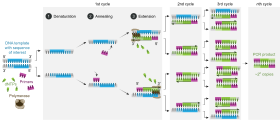DNA synthesis
Nucleotide units are made up of a nitrogenous base (cytosine, guanine, adenine or thymine), pentose sugar (deoxyribose) and phosphate group.In humans, mutations could lead to diseases such as cancer so DNA synthesis, and the machinery involved in vivo, has been studied extensively throughout the decades.[1] These enzymes, along with accessory proteins, form a macromolecular machine which ensures accurate duplication of DNA sequences.DNA replication machinery is therefore highly controlled in order to prevent collapse when encountering damage.The DNA of humans is subject to damage from multiple natural sources and insufficient repair is associated with disease and premature aging.It involves copying RNA into double-stranded complementary DNA (cDNA), using reverse transcriptase enzymes.For many experiments, such as structural and evolutionary studies, scientists need to produce a large library of variants of a particular DNA sequence.In 2010 J. Craig Venter and his team were the first to use entirely synthesized DNA to create a self-replicating microbe, dubbed Mycoplasma laboratorium.Other techniques for synthesising DNA have been commercially made available, including Short Oligo Ligation Assembly.[10] Some studies have explored the possibility of enzymatic synthesis using terminal deoxynucleotidyl transferase (TdT), a DNA polymerase that requires no template.With its ultrahigh storage density and long-term stability, synthetic DNA is an interesting option to store large amounts of data.



deoxyribonucleic acidmacromoleculenucleotideDNA replicationpolymerase chain reactiongene synthesisartificial gene sequencespolynucleotideseukaryotesprokaryotesvirusescell divisionenzymesS phasetopoisomeraseshelicasesuncoilDamaged DNAenzymatic repair processespremature agingnucleotide excision repairbase excision repairmismatch repairhomologous recombinationalnon-homologous end joiningmicrohomology-mediated end joiningretrovirusesreverse transcriptaseintegraseDNA meltingArtificial gene synthesisin vitroJ. Craig VenterMycoplasma laboratoriumOligonucleotide synthesisoligonucleotideschromosomesphosphoramiditeMarvin H. Caruthersterminal deoxynucleotidyl transferaseDNA data storagenucleobaseadeninethymineguaninecytosineHachimoji DNABibcode